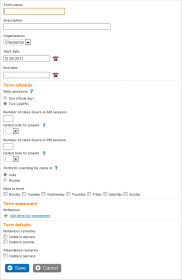Open topic with navigation (left menu)
A term is a division of the year, a block of weeks during which the organisation holds classes. These divisions may also be called semesters, quarters, or trimesters, for example, depending on the institution and the country. In itslearning, the administrator manages terms from Admin >> Terms. Terms are added on organisation level. A profile setting determines whether a profile is allowed to manage terms (see Granting term management rights to a profile under How-tos below).
It is recommended that before you add a term, you add attendance categories and attendance codes. Important: You must have at least one code that indicates presence information.
Note: A term cannot be edited once it has been added for a course.

A daily session is the total number of hours you have in a school day. There are two types of daily sessions: One (whole day) for organisations using a 24-hour clock and Two (AM/PM) for those using a 12-hour clock. The 24-hour clock is a convention of timekeeping in which the day runs from midnight to midnight and is divided into 24 hours, numbered from 0 to 23. The 12-hour clock divides the 24 hours of the day into two periods: the hours before noon (numbered 1 to 11, followed by ‘am’ for ‘ante meridiem’ (Latin for ‘before midday’) and the hours following that before midnight, followed by ‘pm’ (for ‘post meridiem’, Latin for ‘after midday’).
Choose whether to count the class sessions in units or minutes. A unit could, for example, be a lesson or a period. If 'Count class in minutes' is selected, it is possible for a mentor to decide the default length of an individual class session in minutes.
One (whole day): Using this session allows you to refer to the total number of hours in a school day – for example, from 08:00 to 16:00. The number of class hours per day would then be eight.
Two (AM/PM): The system of two daily sessions is used at schools that apply the 12-hour clock, or two daily sessions (for example, before and after lunch). It allows you to specify the number of class hours in the morning and afternoon/evening sessions. If the school day lasts from 8:00am to 4:00pm, you enter ‘4’ in the field Number of class hours in AM session, and ‘4’ in the field Number of class hours in PM session.
As manually keeping account of who is present involves too much work, itslearning allows you to select a default code indicating that a learner is present. If nothing else is stated, all participants are assumed present. When the absence information for a course is sent to the mentor, itslearning automatically inserts the default code for presence in the attendance overview.